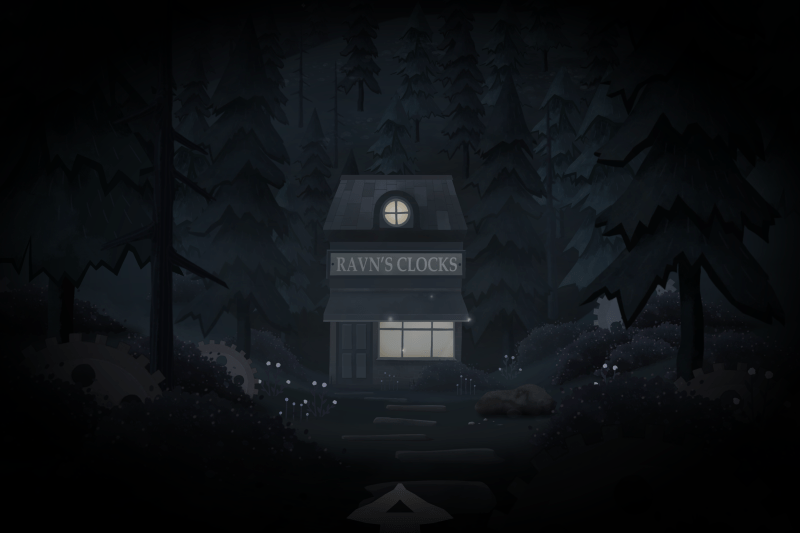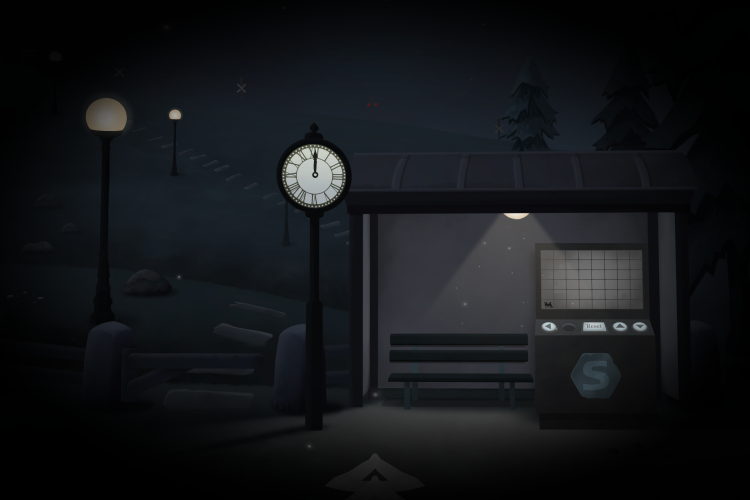Tick Tock is a surreal mystery game where time is of the essence. Its 2D hand-drawn world borrows from 1930s Denmark, but with a magic realist twist. Two players must work together to solve puzzles and unravel a story about two sisters, Amalie and Lærke, who have somehow learned how to manipulate time to grant themselves longer lives. It’s the debut game for Other Tales Interactive, and look for it in Q4 for PC and mobile devices.
The studio is Mira Dorthé and Tanja Tankred, who met while they were both university students. The duo drew inspiration from myriad sources while coming up with the idea for Tick Tock. Cyan, Inc.’s classic mystery adventure Myst influenced its atmosphere; Steel Crate Games’ Keep Talking and Nobody Explodes led them to experiment with centering the gameplay on player cooperation; and Simogo’s Year Walk encouraged them to draw on their Scandinavian roots. Dorthé is Swedish and Tankred is Danish, and they decided to base the game on Danish history.
Scattered throughout are literary references, nods to Dorthé’s background in creative writing and linguistics and Tankred’s in comparative literature. When I tried a demo last week at the Game Developers Conference, Dorthé pointed out allusions to novels like Jonathan Swift’s Gulliver’s Travels and fairy tales like Hans Christian Andersen’s The Nightingale. She also enthused about the historical accuracy of many of the details, like period-appropriate radio advertisements.
“We’ve been doing a bit of research,” Dorthé said. “Like, this is how much shampoo for your dogs would cost at this time in Denmark. That’s been a lot of fun to see.”
June 5th: The AI Audit in NYC
Join us next week in NYC to engage with top executive leaders, delving into strategies for auditing AI models to ensure fairness, optimal performance, and ethical compliance across diverse organizations. Secure your attendance for this exclusive invite-only event.
The multiplayer is entirely offline. Instead of connecting to a server, each player selects on their device if they’ll be Player One or Two and that dictates what clues they’ll get. It plays very much like a point-and-click game, though you’re not controlling a character. Rather, you move between scenes of a world and hunt for solutions to whimsical conundrums. In one puzzle, Dorthé had to tune a radio to find a date for me to enter into a calendar. Once she told me that information, I could open a locked cabinet that contained clues for our next puzzle.
In Tick Tock, sometimes the text floats around on the screen and you have to rearrange it. Other times, you’re spinning the world as though it’s one big mechanical clock. The game traverses 15 years of time, starting when Amalie and Lærke are 10 and 12 years old, but you never meet them. Instead, you’re exploring a peculiar world that’s beholden to a charming fairy tale logic, with an intriguing sense of something sinister lurking just beneath.
Here is an edited transcript of our interview.

GamesBeat: For people who might not have a friend to play with in person, are you planning to setting up an online lobby, something like that?
Mira Dorthé: We’re thinking of working on something like that. Because we’re not so used to this medium before, but people have said that something like Discord could be a really good thing, because we could have a channel where people could search for someone to play with.
You can play it over Skype as well, so that would be pretty good. It’s a little like an “escape the room.” You see different things and have to read things out loud to each other.
GamesBeat: You said it’s similar to the movie Jumanji?
Dorthé: It’s a bit like that. The clockmakers in the story, they made these puzzles for us. You start the game and you have to finish it before time runs out. It’s a little eerie. This is the first level of the game we have here [in the demo].
I’m the programmer, and the girl I’m working with, Tanja, she’s doing all the art. We started the project as a master’s thesis. We were writing about it, doing prototype drafts, and people enjoyed that a lot, so we said, OK, now we have to learn how to do everything else about game-making.
GamesBeat: What’s the gameplay like?
Dorthé: We were thinking a bit about Keep Talking and Nobody Explodes. That one has the same communication thing as well. You’re supposed to tell a story to your friend, and we have some of that as well. One puzzle is in this little timber house.
When you go into the same locations, that’s when you find the puzzles you need. This one is the same room, but it’s to the left a bit. There are some thing as well, when you compare screens—you can see similarities, and you realize you’re in the same place.
GamesBeat: Did you always want to make it for mobile?
Dorthé: Yeah, we wanted to make it for mobile, just to show people—to try and catch people who don’t play many games. Or we thought so. We weren’t sure where exactly they were. It’s so accessible. It’s easier for two people to have two phones instead of two computers, especially if you want to play in the same room.
Then we realized we could just use any medium, all the platforms. There are lots of interactions where it feels nicer to click on things rather than using your fingers. It’s an interactive story in a sense, where the text holds the solutions to the puzzles.
GB: You mentioned Year Walk was an inspiration. Are you incorporating mythology at all, or just history?
Dorthé: It’s just historical for now. The Fastelavn thing, which is like [Danish] Halloween—I’m Swedish, so I don’t know as much as Tanja does, but she told me all about it. We want to have elements where it feels very grounded in itself, and then—I don’t know if you call it magical realism? This girl, the clockmaker in the game, she’s built this world where she creates puzzles and plays games with her sister.
GamesBeat: Do you both also have a background in interactive fiction, like Twine or anything else?
Dorthé: We don’t, actually. We both started making games at university, working on this two-year master’s degree. Before that we hadn’t made any games or anything before. I learned how to program and Tanja got way better at her art. She knew some things, and she learned a lot more.
We probably should have started with something simpler, but we decided to do this two-player non-networked thing. We maybe want to do something more Twine-like afterward, where it’s more interactive. We realized after a year of making this—we didn’t know so much, so we’d tear everything down and rebuild it again with our new skills. That’s when we realized how big this thing actually was. It felt pretty cool, to realize that we can do this. We have our foundation in the storytelling, and we just want to see how much we can do on top of that.
GamesBeat: What was the most challenging part of developing the game?
Dorthé: For me, of course, it was programming. I started with this visual scripting called PlayMaker, which was brilliant just for learning how programming works. There’s this other way of thinking you have to get, and at first I didn’t get it at all.
Then maybe half a year ago I started to rewrite everything in code. That was the hardest, but it still felt very quick, to go from not knowing anything to making a game that works. That’s been really cool.
Also, it’s been two of us for a very long time, and now we just hired two freelancers part-time. There’s been some animation and sound design work. But otherwise—we started the company at the same time we started making the game, straight after university. It was hard to juggle the business side with making the game, because there’s so much time we have to allocate that as well.
GamesBeat: Did you have to find funding?
Dorthé: In the very beginning, after we graduated, we got into a Swedish accelerator program at Stugan. We were there for two months and they cooked us food and we had a really nice time—we were able to completely focus on the game. That’s when we decided to start the company as well.
After that, we went out looking for money. We’re partially funded by the Danish government. They have a thing called the Danish Film Institute that also gives money to games. We’ve gotten that three times — twice for making the prototype, and then now for the full game. We’re also funded by Coffee Stain, who made Goat Simulator. They have a new initiative we’re part of. We’re fully funded for the production of this game.
GamesBeat: Is it difficult to come up with different mechanics that will match the story?
Dorthé: There’s a lot of simply finding things. You’re dropped into this world where you don’t know—you play yourself in the game. When you get in there, we want you to meet things that feel like what you could do in real life. When Tanja draws things, she makes sure that everything would work in real life, and usually the programming is hard-coded and set up in a way that this machine would work physically, if that makes sense.
Things like that—it doesn’t feel limiting at all. It just feels like, we know that this would be the best puzzle. I’ll learn how to program it, and Tanja will figure out the best way to draw it. My programming skills are very varied. I don’t know a lot of the basics, but I know a lot about quaternions, rotations and stuff.
The hardest part, as well, has just been designing for two people. It’s not networked, so I have no idea what you’re doing. The games don’t know what each other is doing. That’s just a lot of probability and stuff, so players don’t accidentally solve things by themselves. That’s been a lot of fun.
GamesBeat: Did you come up with the story first, and then break that into what the two players would be experiencing? Or did you come from the setting first?
Dorthé: We did everything at the same time, or as much as we could, because we wanted to make sure we could tell the story we wanted in the way that we wanted to build the game, if that makes sense. We want to have—the things we realized, OK, we need to make a world where one of the characters has built everything. She’s a master clockmaker, so she can make these wonderful things. There will be more of those things coming later as she grows better at making them. There will be more fine mechanical birds and things like that as well.
GamesBeat: It feels very much like you’re playing with physical objects. Was that part of the inspiration of having these little mechanical things?
Dorthé: Definitely. It helped a lot with both drawing and coding it. We needed to see something physical to be able to make that in a digital way. We have all these little puzzle parts, and they’re all objects. Everything is supposed to feel like you’re in here somehow. You can touch things. You should feel like you can interact with everything as much as possible.
We have here, in front of the clock shop, there’s the gear. You should feel like you’re in this clock. Also, here at the bottom, there’s the minute hand. There are little clues for how to navigate in the world by searching. There’s a lot of that adventure feeling, going on an adventure with your friend.
IndieBeat is GamesBeat reporter Stephanie Chan’s weekly column on in-progress indie projects. If you’d like to pitch a project or just say hi, you can reach her at stephanie@venturebeat.com.


